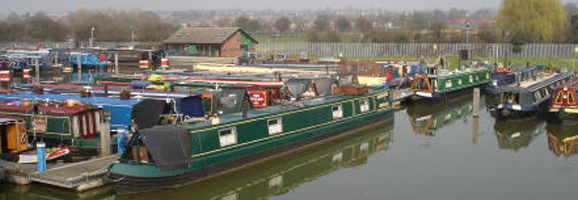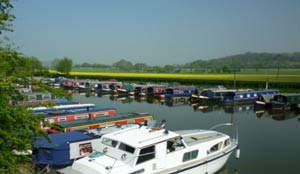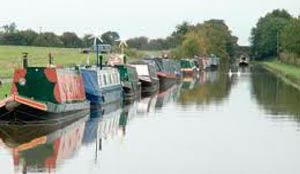
In this article I’ll try to show what options are available with regards to narrowboat mooring particularly residential moorings on the canals and rivers of the UK. I am not going to discuss the rights and wrongs of the interpretation of the rules – these have been written about at great length and wildly differing opinions can be found on any canal user forum and canal magazine Readers Letters pages every month. On a personal note, your author has continually cruised, moored in a marina, had a long term online mooring from BW and moored on private land alongside the canal, so I feel reasonably well placed to offer an opinion of the advantages and disadvantages of all types of narrowboat moorings.
It’s a sad fact, but one of the things many new narrowboaters (or indeed any boat using the canals and rivers of the UK) tend to overlook is the fees associated with mooring your vessel. There is an awful lot written about the merits and otherwise of continuous cruising i.e. without any form of permanent mooring for your boat (but I’ll come back to this later in this article.)
Put bluntly, if you own a boat and do not ‘continually cruise’ you will need somewhere to moor that boat when you are not using it. There are a number of different ways and types of mooring and each has its own merits (and drawbacks). I don’t want to politicise this article so I will try and show the various alternatives available and leave it to you to decide which is best for your needs.
On the face of it, there are two places you can moor your narrowboat – either alongside the canal (sometimes called tow-path moorings) or within the confines of a marina.
Marina moorings
These can offer the boater added security with additional services, such as an electric hook-up, fresh water and refuse disposal, and many are able to provide engineering services from a resident marine engineer – useful if you want to keep your boat in tip top condition, but are unsure (or unwilling!) to carry out the work yourself. Some marinas offer parking places for your car while you are out cruising on your boat, but may have rules in place as to how long you can stay on your vessel whilst it is inside the marina.
 As more and more people look to the canals as a way of living on a narrowboat, some marinas are turning a blind eye to what are often described as ‘long term moorers’. These are individuals who effectively use their boat as either a second home for part of the year or (as is becoming more common) live on that boat all year round with a friend or relative providing a ‘home address’ for paperwork purposes.
As more and more people look to the canals as a way of living on a narrowboat, some marinas are turning a blind eye to what are often described as ‘long term moorers’. These are individuals who effectively use their boat as either a second home for part of the year or (as is becoming more common) live on that boat all year round with a friend or relative providing a ‘home address’ for paperwork purposes.
Marina rates vary dramatically, particularly around the country, and in popular areas in the south for example, can exceed £5000 a year for a 50ft boat. Remember – this is on top of your ‘normal’ cruising licence that is paid to the licencing authority.
Rates for narrowboat moorings in London and in particular, narrowboat moorings in Central London, can be higher still, but you must also remember that it is not just the cost that is a problem – the scarcity of these moorings mean that they command a premium and just finding a permanent mooring is an issue. Sometimes, potential boaters can circumvent the usual waiting list for a mooring by buying a boat that is already moored on a permanent site – but a word of caution here – you must ensure that the seller has the right to transfer his / her mooring. Get in touch with the owner of the moorings themselves to confirm this, before parting with your money….
Contract lengths for mooring can vary from a full 12 month moorings to those where just a week or two is required. Even boaters who continually cruise will often moor in a marina for a month or two over the winter to avoid the worst that the British weather can throw at them.
Online Moorings
As mentioned earlier, online moorings usually mean those alongside the towpath (or opposite side of the canal). Some of these are owned by BW – or The Canal and River Trust, some are owned by Local Authorities or Park Agencies in such places as Milton Keynes and Loughborough and some are owned by private landowners.

Facilities vary dramatically from none whatsoever, to water / refuse and electric points. Unlike marina moorings, security can be an issue, and the only time I have ever had anything stolen from a narrowboat has been when it has been moored alongside the canal. It is also important to remember that even on privately owned moorings; you will normally have to pay the Canal and River Trust for a Mooring Licence as well as the owner of the land – and all of this is on top of your ‘normal’ boat licence costs.
Many areas of the canal are designated as ‘visitor moorings’. In essence, the narrowboat owner can moor alongside a length of bank for a period (usually not exceeding 14 days). Read the mooring notices carefully though. Several places where mooring is popular have much shorter visitor waiting periods, and additional charges are made for narrowboats who overstay. As these can be quite hefty, the narrowboater who ignores the mooring notice can find themselves with an unwelcome bill at the end of their mooring period.
Continuous Cruising
OK – I’ve left the contentious one till last. The Canal and River Trust accept that the law is quite ambiguous and as a result, have published their ‘Guidance for boaters without a home mooring’. In it, they state that:
You must use your boat to genuinely cruise in a mainly progressive fashion (A to B to C to D rather than A to B to A to B) from place to place and must not stop for more than 14 days in any one place, except in exceptional circumstances beyond your control.
They also say that if you don’t move your boat across a wide enough area or stay in one place too long, they might actually apply to have your boat removed from the water.
As a result, and by way of guidance, the Canal and River Trust suggest you ask yourself two questions to see if you fit the continuous cruiser ‘profile’.
- Are you free of obligations that would see you having to remain in one area, such as childcare or education, employment or health care?
- Can you commit to moving your boat to a truly new area every 14 days
They suggest that if you answer no to either of those questions, then you could not really consider yourself a continuous cruiser.
Available moorings are often advertised in boating magazines so a regular trawl through these can be useful, as can a visit to marinas in the area that you would like to moor your boat.

Hi Colin,
Thanks for your wonderfully informative articles. I have a question – do you think the canal network is congested or becoming congested as more and more people look for alternative life styles or wish to escape the house owning options?
Many thanks. Richard
Hi Richard – thanks for your kind comments. In answer to your question – some areas of the canal system have become a bit more congested over the last few years, but many boaters have also given up their vessels due to increasing costs of moorings, licences, fuel etc, so in effect, the two have cancelled each other out to a degree. What has changed is the demographic of the type of people now on the canals, and there has been an increase in people using narrowboats as an alternative form of housing as property prices have risen.
Hi Boaters, I am considering living onboard after 24years military service. I would like a continuous cruising licence and travel about the canal network. My question is will i be able to afford this life style after buying a boat outright on just £600 per month as this would be my only income? Thanks Darren 😐
Darren – your question is a bit difficult to answer as the boat length is taken into consideration when calculating licence costs. Check on the Canal & River Trust’s website for the latest rates. Remember – you will need at least third party insurance to obtain a licence, so factor this into your costs too. Other drains on your budget will be fuel, (both diesel and solid fuel if you have a stove) possible pumpout costs (unless you have an elsan loo), any mooring costs for ‘honeypot’ sites, and your own food & drink etc.
Good information. Lucky for me I came across your blog by accident
(stumbleupon). I’ve saved it for later!
My Partner and I have been at sea for the best part of 30 odd years. We have a permanent residence (house) on the south coast but we are more than interested in trying to buy a narrowboat and living aboard maybe Monday to Friday and longer over the summer. As we have a permanent address elsewhere and we pay our Council Tax there, would we be classed as permanent residents at a marina/mooring or is the another level of classification for this?
My work basically means I can be based anywhere as long as I can get access to an airport and my partner attends meetings in London on a fairly frequent basis so somewhere commutable (within an hour or so) to Central London would be preferable. We would intend to cruise at weekends and during the summer months (possibly running home to the fire in the winter).
We have only just started to look at this so any advice would be more than welcome, we have done a couple of narrowboat holidays and with her being a master mariner and me a Chief Engineer we think we can cover most things except maybe the bureaucracy…..????
Many Thanks
Chris
Hi Chris – your classification in a marina will largely depend upon the marina in question. Many are quite happy to have what they call ‘long term moorers’ that have no residential status (i.e. they insist you have a legitimate ‘home’ address) as they do not want to get involved in the vagaries of council tax etc. Some will allow post to go to the marina office, but this is by no means consistent.
You can arrange for any post to be sent to a local Post Office for collection using their ‘Poste Restante’ service – there is not normally a charge for this. Do remember that the Canal and River Trust insist you keep on the move if you are out on the cut – you would not be able to moor in one area and work unless you were in a marina…
Great site thanks.
My question is;
I am an English/Australian and was considering buying a narrowboat and living on it for most of the year and going back to the Australian summer.
I would have no permanent/mailing address in the UK.
I am receiving an English pension.
What would be any problems you could for see with the idea?
I would have no problems about mooring it ‘away from the maddening crowds’ over winter.
TAI
Stuart.
Hi Stuart – having no permanent mailing address shouldn’t cause you problems – you can use the ‘Poste Restante’ service at the post office and have post sent to a post office for you to collect. If you need to moor over winter, you would need to use a legitimate mooring facility and not just moor up away from the madding crowd, as it were. C&RT take a dim view on boats left for long periods in one place! Beyond that, I see no real problem and wish you good cruising…
Hi, I am thinking seriously now about buying my first narrowboat after waiting for several years for my children to be at a safe age to spend holidays on a narrowboat. Does anybody know if we are legally allowed to hire it out to friends, relatives etc from any mooring when we are not using it? I do understand that I would require a different licence to allow me to do this but not sure about the situation with moorings, does it need to be linked to an address ?does anyone know monthly costs for this. Does anybody already do this who has any advice to offer? Thanks
Hi Karl – there must be plenty of people out there who could answer your question better than I can. You are right that you may need a commercial license and certainly some better form of insurance than you probably have at present. Beyond that I ask the boating community to answer your question in more detail…
Thanks for this information, its cleared a few things up for me.
My Dad is about to put his Narrow Boat in a Non Residential Marina and he has a land address some where else plus he pays council tax ect for his house….
What might be classed as living on the boat residentially, the Marina has stated it does not keep tags on people when they come on and off site and they do not take in any post, what i mean to ask is could my dad live on the boat for 3 nights a week and not get accused of living on the boat residentially. ?
thanks
Hi Charlie – Many marinas allow what they term ‘long term moorers’ who effectively live on their boats a good deal of the time. Most marinas will only allow this if the moorer is able to prove that they have a ‘proper’ residential property in their name, and turn a blind eye. Most will not allow post to be sent to the marina as it should not be the principal address for the boat owner (although i have come across a few marinas who have waived that ruling)